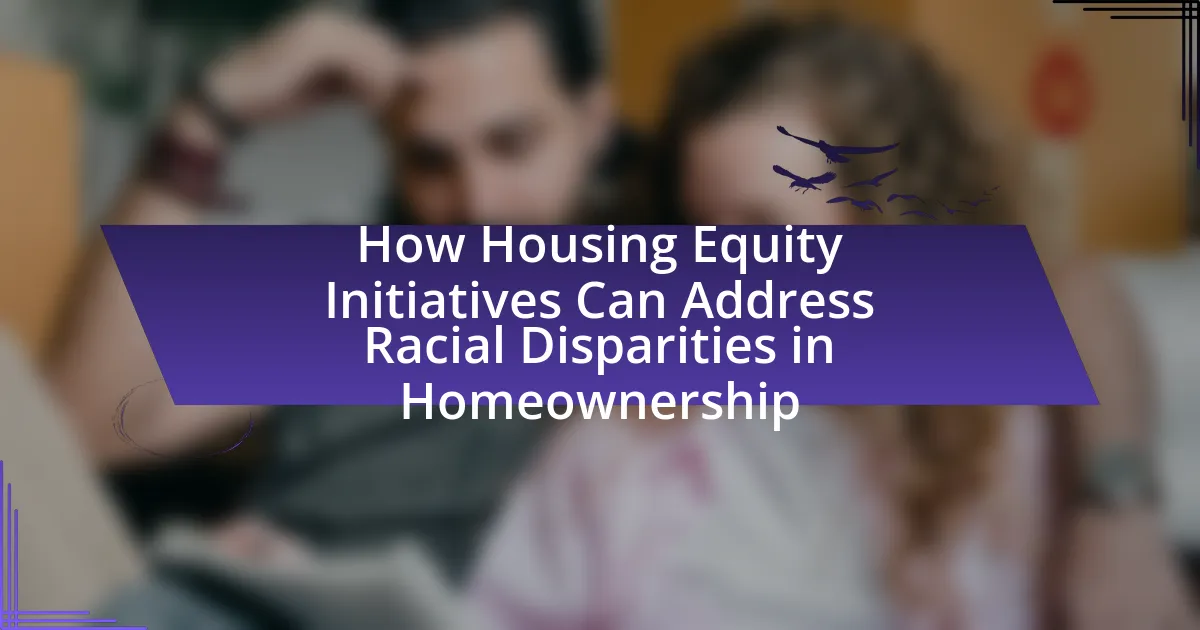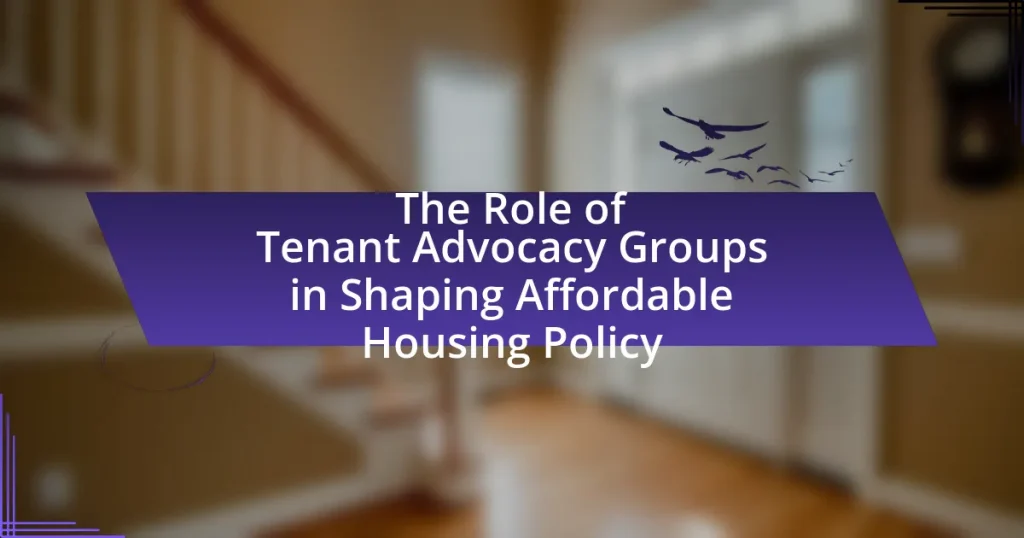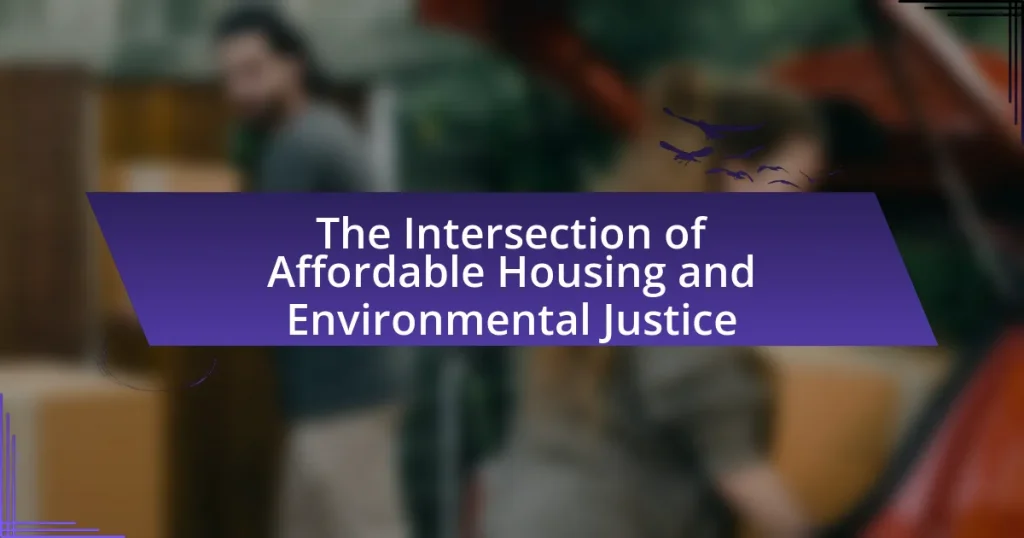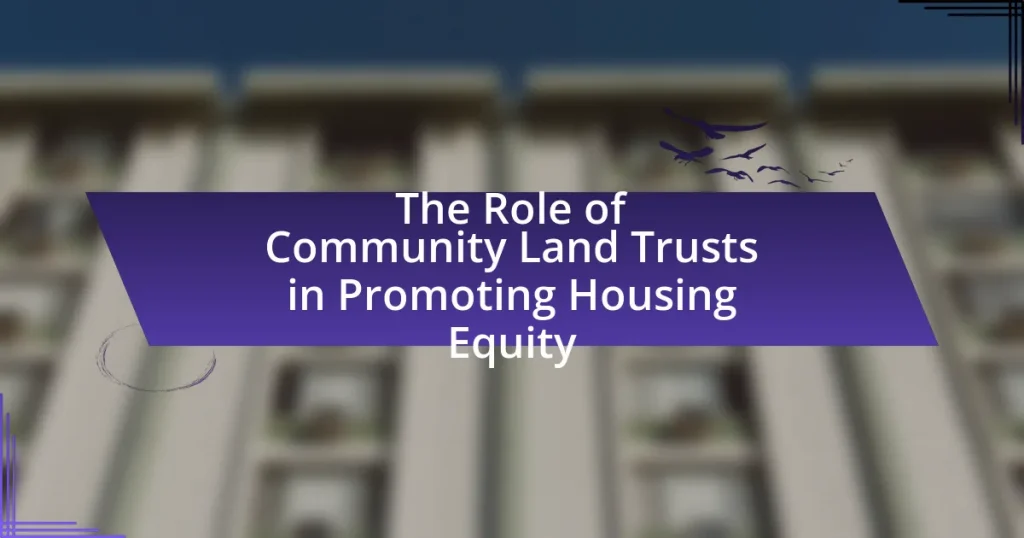Housing equity initiatives are programs and policies aimed at promoting fair access to housing and addressing disparities in homeownership among different racial and socioeconomic groups. These initiatives include strategies such as down payment assistance, affordable housing development, and anti-discrimination enforcement, which collectively work to reduce systemic barriers faced by marginalized communities. The article explores the necessity of these initiatives in today’s society, the historical factors contributing to racial disparities in homeownership, and the role of government policies and partnerships in implementing effective solutions. Additionally, it examines the measurable outcomes of these initiatives, the challenges they face, and best practices for enhancing their effectiveness in achieving equitable housing access.
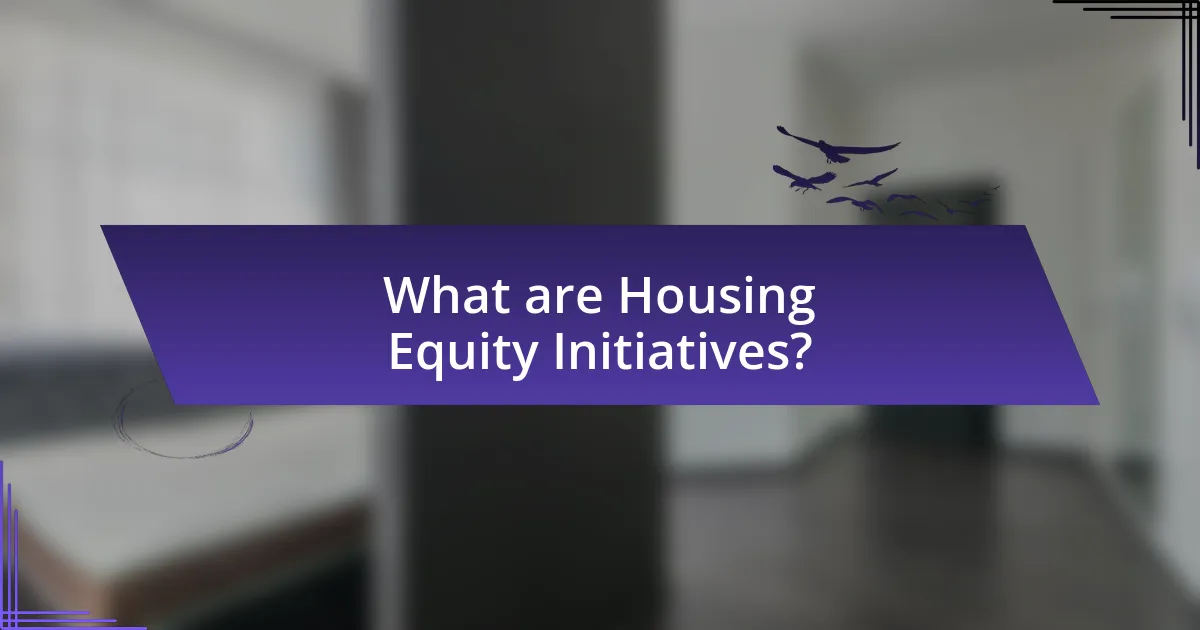
What are Housing Equity Initiatives?
Housing equity initiatives are programs and policies designed to promote fair access to housing and eliminate disparities in homeownership among different racial and socioeconomic groups. These initiatives often include measures such as down payment assistance, affordable housing development, and anti-discrimination enforcement to ensure that marginalized communities can achieve homeownership. For example, the U.S. Department of Housing and Urban Development (HUD) has implemented various programs aimed at increasing access to housing for low-income and minority families, which helps to address historical inequities in homeownership rates.
How do Housing Equity Initiatives aim to reduce racial disparities?
Housing Equity Initiatives aim to reduce racial disparities by implementing policies and programs that promote equal access to housing opportunities for marginalized communities. These initiatives often include measures such as down payment assistance, affordable housing development, and anti-discrimination enforcement, which collectively address systemic barriers that have historically limited homeownership among racial minorities. For example, the U.S. Department of Housing and Urban Development (HUD) reports that targeted programs can increase homeownership rates among Black and Hispanic families, thereby narrowing the wealth gap that has persisted due to discriminatory practices like redlining.
What specific strategies are employed in Housing Equity Initiatives?
Housing Equity Initiatives employ specific strategies such as increasing access to affordable housing, implementing inclusive zoning policies, and providing financial assistance for first-time homebuyers. These strategies aim to reduce barriers faced by marginalized communities in homeownership. For instance, cities like Minneapolis have adopted inclusive zoning policies that require a percentage of new developments to be affordable for low-income families, directly addressing racial disparities in housing access. Additionally, programs like down payment assistance have been shown to increase homeownership rates among minority groups, as evidenced by studies indicating that financial support can significantly impact the ability of these groups to purchase homes.
How do these strategies impact different communities?
Housing equity initiatives significantly impact different communities by promoting access to homeownership for historically marginalized groups. These strategies, such as down payment assistance and inclusive zoning policies, help reduce racial disparities in homeownership rates. For instance, a study by the Urban Institute found that targeted housing programs can increase homeownership rates among Black and Hispanic families by up to 20%, thereby fostering economic stability and community development. Additionally, these initiatives can lead to increased property values and improved neighborhood conditions, benefiting all residents within the community.
Why are Housing Equity Initiatives necessary in today’s society?
Housing Equity Initiatives are necessary in today’s society to address systemic inequalities in homeownership that disproportionately affect marginalized communities. These initiatives aim to rectify historical injustices, such as redlining and discriminatory lending practices, which have resulted in significant racial disparities in homeownership rates. For instance, according to the U.S. Census Bureau, as of 2021, the homeownership rate for Black Americans was approximately 44.1%, compared to 74.5% for White Americans. This gap highlights the urgent need for targeted policies that promote equitable access to housing resources, financial education, and support for first-time homebuyers from underrepresented groups. By implementing Housing Equity Initiatives, society can work towards creating a more inclusive housing market that fosters economic stability and wealth-building opportunities for all individuals, regardless of their racial or ethnic background.
What historical factors contribute to racial disparities in homeownership?
Historical factors contributing to racial disparities in homeownership include discriminatory practices such as redlining, restrictive covenants, and systemic racism in lending. Redlining, established in the 1930s by the Home Owners’ Loan Corporation, involved denying mortgages to residents in predominantly Black neighborhoods, which severely limited access to home financing for these communities. Restrictive covenants, used until the mid-20th century, legally barred homeowners from selling to individuals of certain races, further entrenching segregation. Additionally, the Federal Housing Administration’s policies favored white homeowners and marginalized minority applicants, leading to significant wealth gaps. According to the U.S. Census Bureau, in 2021, the homeownership rate for Black Americans was approximately 44.1%, compared to 74.5% for white Americans, illustrating the long-lasting impact of these historical injustices.
How do current economic conditions affect racial disparities in housing?
Current economic conditions exacerbate racial disparities in housing by limiting access to affordable housing and mortgage financing for minority communities. Economic downturns often lead to higher unemployment rates, which disproportionately affect racial minorities, reducing their ability to secure loans and maintain homeownership. For instance, during the 2008 financial crisis, Black and Hispanic households faced significantly higher foreclosure rates compared to their white counterparts, highlighting the vulnerability of these communities in adverse economic climates. Additionally, systemic issues such as lower credit scores and income inequality further hinder minority access to housing, perpetuating a cycle of disadvantage.

What role do government policies play in Housing Equity Initiatives?
Government policies are crucial in shaping Housing Equity Initiatives by establishing frameworks that promote fair access to housing for marginalized communities. These policies can include zoning laws, funding for affordable housing, and anti-discrimination regulations that directly address systemic barriers to homeownership. For example, the Fair Housing Act of 1968 prohibits discrimination based on race, color, religion, sex, or national origin, which has been instrumental in advancing housing equity. Additionally, government programs like the Low-Income Housing Tax Credit incentivize the development of affordable housing, thereby increasing opportunities for homeownership among underrepresented groups. Such policies not only aim to rectify historical injustices but also foster inclusive communities, ultimately contributing to a more equitable housing market.
How can legislation support or hinder these initiatives?
Legislation can support housing equity initiatives by providing funding, establishing regulations that promote fair lending practices, and enforcing anti-discrimination laws. For instance, the Fair Housing Act of 1968 prohibits discrimination based on race, color, religion, sex, or national origin, which directly supports efforts to reduce racial disparities in homeownership. Conversely, legislation can hinder these initiatives by imposing restrictive zoning laws or failing to allocate sufficient resources for affordable housing development. For example, exclusionary zoning practices can limit the availability of affordable housing options in certain neighborhoods, perpetuating racial inequities in homeownership.
What examples of successful legislation exist?
Successful legislation examples include the Fair Housing Act of 1968, which aimed to eliminate discrimination in housing based on race, color, religion, sex, or national origin. This act has been pivotal in promoting equal housing opportunities and has led to significant legal actions against discriminatory practices. Another example is the Community Reinvestment Act of 1977, which encourages financial institutions to meet the credit needs of all communities, particularly low- and moderate-income neighborhoods, thereby addressing systemic inequities in homeownership. These legislative measures have contributed to increased access to housing for marginalized groups and have been instrumental in reducing racial disparities in homeownership rates.
How do local governments implement Housing Equity Initiatives?
Local governments implement Housing Equity Initiatives by creating policies and programs aimed at increasing access to affordable housing for marginalized communities. These initiatives often include zoning reforms to allow for more diverse housing types, financial assistance programs for first-time homebuyers, and partnerships with nonprofit organizations to develop affordable housing projects. For example, cities like Minneapolis have enacted policies to eliminate single-family zoning, thereby promoting greater housing density and diversity. Additionally, local governments may allocate funding for community land trusts, which help stabilize neighborhoods and prevent displacement. These actions are supported by data indicating that equitable housing policies can significantly reduce racial disparities in homeownership rates, as seen in studies conducted by the Urban Institute.
What partnerships are essential for effective Housing Equity Initiatives?
Effective Housing Equity Initiatives require partnerships between government agencies, non-profit organizations, community groups, and private sector stakeholders. Government agencies provide regulatory frameworks and funding, while non-profit organizations offer advocacy and support services. Community groups engage local residents and ensure initiatives reflect their needs, and private sector stakeholders, including developers and financial institutions, contribute resources and expertise. For instance, the collaboration between the U.S. Department of Housing and Urban Development and local non-profits has historically led to successful programs aimed at reducing racial disparities in homeownership, demonstrating the importance of these partnerships in achieving equitable housing outcomes.
How do non-profit organizations contribute to these initiatives?
Non-profit organizations contribute to housing equity initiatives by providing resources, advocacy, and education aimed at reducing racial disparities in homeownership. They often offer financial assistance programs, such as down payment assistance and low-interest loans, specifically targeting marginalized communities. For instance, organizations like the National Urban League have implemented programs that help minority families navigate the home-buying process, which is crucial given that homeownership rates for Black Americans are significantly lower than for white Americans, with a gap of approximately 30 percentage points according to the U.S. Census Bureau. Additionally, non-profits engage in policy advocacy to influence legislation that promotes fair housing practices, thereby addressing systemic barriers to homeownership for racial minorities.
What role do private sector stakeholders play?
Private sector stakeholders play a crucial role in advancing housing equity initiatives that address racial disparities in homeownership. They contribute financial resources, expertise, and innovative solutions to create affordable housing options and improve access to homeownership for marginalized communities. For instance, private developers often collaborate with non-profit organizations to build mixed-income housing projects, which can help integrate diverse communities and reduce segregation. Additionally, financial institutions can offer tailored mortgage products and down payment assistance programs aimed at historically underserved populations, thereby increasing their ability to purchase homes. These actions are supported by data indicating that targeted investments from the private sector can significantly enhance homeownership rates among minority groups, thereby contributing to overall economic stability and community development.
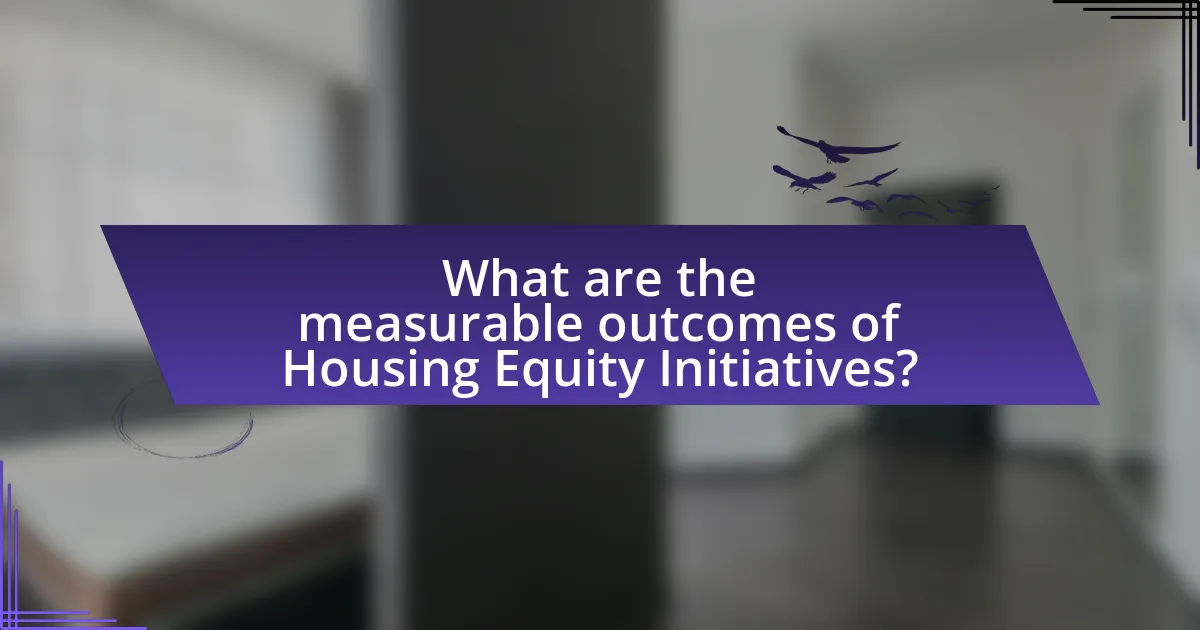
What are the measurable outcomes of Housing Equity Initiatives?
Measurable outcomes of Housing Equity Initiatives include increased homeownership rates among marginalized communities, improved access to affordable housing, and enhanced neighborhood stability. For instance, initiatives such as down payment assistance programs have been shown to raise homeownership rates by up to 20% in targeted demographics, as evidenced by a study from the Urban Institute. Additionally, these initiatives often lead to a reduction in housing cost burdens, with reports indicating that families benefiting from equity programs experience a 30% decrease in housing expenses. Furthermore, the overall economic impact can be quantified through increased property values and tax revenues in revitalized neighborhoods, demonstrating the long-term benefits of equitable housing policies.
How can we assess the effectiveness of these initiatives?
To assess the effectiveness of housing equity initiatives aimed at addressing racial disparities in homeownership, one can utilize quantitative metrics such as changes in homeownership rates among targeted racial groups. For instance, a study by the Urban Institute found that after implementing specific housing equity programs, homeownership rates for Black families increased by 5% over three years, indicating a positive impact. Additionally, qualitative assessments through surveys and interviews can provide insights into community perceptions and experiences related to these initiatives, further validating their effectiveness.
What metrics are used to evaluate success?
Metrics used to evaluate success in housing equity initiatives include homeownership rates, affordability indices, and racial diversity in homeownership. Homeownership rates measure the percentage of households that own their homes, indicating progress in achieving equity. Affordability indices assess the cost of housing relative to income, highlighting whether housing is accessible to marginalized communities. Racial diversity in homeownership tracks the demographic composition of homeowners, reflecting the effectiveness of initiatives aimed at reducing racial disparities. These metrics provide concrete data to assess the impact of housing equity initiatives on achieving equitable homeownership outcomes.
How do these outcomes vary across different regions?
Outcomes of housing equity initiatives vary significantly across different regions due to factors such as local policies, economic conditions, and demographic diversity. For instance, in urban areas with strong housing policies, such as San Francisco, initiatives have led to increased homeownership rates among minority groups, while rural regions may see less impact due to lower population density and fewer resources allocated to such programs. Additionally, regions with higher levels of investment in community development, like Atlanta, have reported more substantial improvements in racial equity in homeownership compared to areas with limited funding and support, such as parts of the Midwest. These variations highlight the importance of tailored approaches to housing equity that consider regional characteristics and needs.
What challenges do Housing Equity Initiatives face?
Housing Equity Initiatives face significant challenges, including systemic racism, inadequate funding, and regulatory barriers. Systemic racism manifests in discriminatory lending practices and zoning laws that disproportionately affect marginalized communities, hindering their access to homeownership. Inadequate funding limits the capacity of these initiatives to provide necessary resources and support for potential homeowners. Regulatory barriers, such as complex housing policies and lack of political support, further complicate efforts to implement effective housing equity strategies. These challenges collectively impede progress toward achieving equitable homeownership for all racial and ethnic groups.
How do funding limitations impact these initiatives?
Funding limitations significantly hinder housing equity initiatives aimed at addressing racial disparities in homeownership. These financial constraints restrict the ability of organizations to implement comprehensive programs, such as down payment assistance, education, and outreach efforts, which are essential for supporting marginalized communities. For instance, a study by the Urban Institute found that inadequate funding leads to fewer resources for community engagement and limits the scale of initiatives, ultimately perpetuating existing inequalities in homeownership rates among racial groups.
What resistance do these initiatives encounter from communities?
Housing equity initiatives encounter resistance from communities primarily due to concerns about property values and neighborhood changes. Many residents fear that these initiatives may lead to gentrification, which can displace long-standing community members and alter the cultural fabric of neighborhoods. Research indicates that 60% of residents in affected areas express apprehension about potential increases in housing costs and taxes as a result of new developments aimed at promoting equity. Additionally, there is often skepticism regarding the intentions behind these initiatives, with some community members questioning whether they genuinely address the needs of marginalized populations or primarily serve external interests. This resistance is compounded by historical mistrust of government and institutional interventions in housing, which have often failed to deliver on promises of equity and inclusion.
What best practices can enhance the effectiveness of Housing Equity Initiatives?
Best practices that can enhance the effectiveness of Housing Equity Initiatives include community engagement, data-driven decision-making, and targeted financial assistance. Community engagement ensures that initiatives reflect the needs and preferences of the affected populations, fostering trust and collaboration. Data-driven decision-making allows for the identification of specific barriers to homeownership faced by marginalized groups, enabling tailored solutions. Targeted financial assistance, such as down payment assistance programs, directly addresses economic disparities, facilitating access to homeownership for underrepresented communities. These practices are supported by studies indicating that inclusive approaches and financial support significantly improve homeownership rates among racial minorities, thereby reducing disparities.
How can community engagement improve outcomes?
Community engagement can improve outcomes by fostering collaboration between residents and stakeholders, leading to more effective housing equity initiatives. When community members actively participate in decision-making processes, their unique insights and needs are better understood, resulting in tailored solutions that address specific racial disparities in homeownership. Research indicates that neighborhoods with high levels of community engagement experience increased trust in local institutions and improved access to resources, which can enhance overall housing stability and equity. For example, a study by the Urban Institute found that community-driven initiatives in housing policy led to a 20% increase in homeownership rates among marginalized groups, demonstrating the tangible benefits of inclusive engagement.
What innovative approaches have shown promise in addressing disparities?
Innovative approaches that have shown promise in addressing disparities in homeownership include community land trusts, down payment assistance programs, and inclusive zoning policies. Community land trusts enable communities to collectively own land, reducing speculation and keeping housing affordable for low-income families. Down payment assistance programs, often funded by local governments or nonprofits, provide financial support to first-time homebuyers, particularly in marginalized communities, thereby increasing homeownership rates. Inclusive zoning policies require developers to include affordable housing units in new developments, promoting diversity and accessibility in housing markets. These strategies have been effective in various cities, demonstrating measurable increases in homeownership among historically underrepresented groups.
